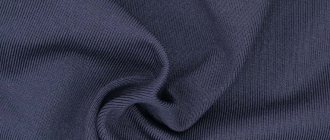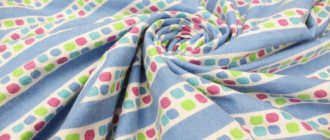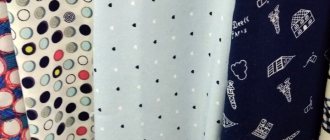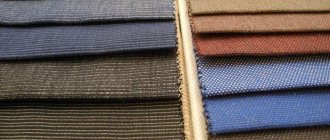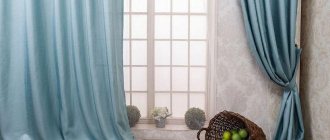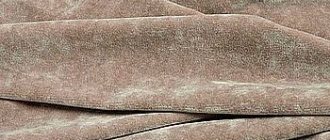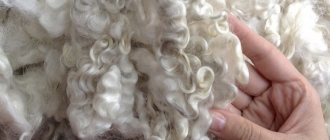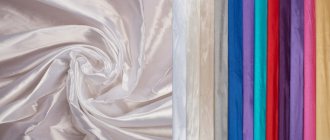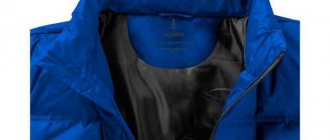History of fabric
Nylon is the first synthetic fabric in the fashion world. The history of nylon began in 1935. American scientist Wallace Carothers, a leading chemist at the DuPont Corporation, was working on a material that could replace natural silk. In the process, he was able to synthesize a durable polymer resistant to aggressive environments from alcohol, water and coal tar. The substance is called polymer 6,6.
Nylon, created on the basis of a new substance, was officially presented to the public in 1939 at the World's Fair in New York in the form of women's stockings. Nylon stockings quickly became a bestseller, making millions of women happy.
The Second World War brought changes to the use of nylon. They had to forget about stockings; all the nylon produced was directed to the needs of the army. Parachutes, tents, awnings for military vehicles, and body armor were made from it.
Long-lasting success of nylon
438 2 min.
Strictly speaking, Carothers synthesized only the first 15 ml of polyhexamethylene adipinamide in February 1935. The working name of this polymer was polyamide-6.6. From this polymer, a synthetic fiber was soon created, which received the trade name Nylon (in the Russian version - nylon).
Photo: AP
There is even a legend about the origin of this word, they say, NYLON = New York + London. True, no one can explain why suddenly the DuPont company, headquartered in Wilmington (Delaware), where Carothers himself worked, needed to glorify New York, and especially London. Nylon first became famous in 1939 in the form of women's stockings, presented at the World's Fair in New York, so the first two letters in its trade name may have something to do with New York, but London clearly has nothing to do with it.
In the first year, 64 million pairs of nylon stockings were sold in the United States, this was DuPont's first success in a new market for the company, and a colossal success! But after the United States entered World War II, nylon was needed for military purposes, and almost all of it was used for parachutes, tents, etc. After the war, it again had to conquer the consumer market.
The history of the creation of nylon is one of the most striking illustrations of the success of an innovative business strategy, as they would say now. In the early 1920s, DuPont, which since its founding in 1802 had specialized in the development of dual-use substances and materials (primarily for military use, but also suitable for civilian purposes), decided to create a synthetic chemistry division. At this time, it was already clear to everyone that the future belonged to synthetic materials.
The company began buying promising young organic chemists from American universities. Thirty-year-old Carothers was chosen to be the head of the division and in 1927 came to DuPont from Harvard University with a salary increase double the university salary and the promise of complete creative freedom without restrictions on the research budget. Within reasonable limits, of course, and with the condition that he would engage in the synthesis of polymers with a molecular weight of more than 4000. The path from them to synthetic rubber was then considered the most promising.
Perhaps Carothers' choice from the point of view of modern HR managers was not the best; he, as it turned out, suffered from mental instability, often became depressed, began to drink (and eventually committed suicide in 1937). But, probably, for his personal talent as a synthetic chemist and talent as an organizer of science, this was forgiven for him. Under his leadership, three years later, DuPont's first synthetic rubber, neoprene, was produced. It is still one of the most popular materials in many areas of industry, and its consumer qualities are well known to divers from their diving suits. The next was polyester fiber and synthetic fabric made from it - polyester (polyester), which probably does not need to be introduced to the modern public. And then nylon arrived.
After World War II, the original nylon-66 had many slightly modified clones, including in our country. But in our country this dual-use polymer entered the consumer market quite late. The peak of Soviet fashion for nylon came during the “warming” of the 1960s, when the “Iron Curtain” opened slightly for the import of Western consumer goods. Italian white nylon shirts that did not need to be ironed, ladies' stockings and men's socks of delightfully bright colors, Japanese nylon jackets, and Japanese swimming trunks and swimsuits, which very favorably emphasized to the bathers what was worth emphasizing on the beaches of Jurmala, Yalta and Sochi, poured into the country . When the Soviet light industry finally mastered the production of products from domestic nylon (anide and enant), it hopelessly went out of fashion.
Nylon jackets moved into country wardrobes, and white nylon shirts with a dark tie with an elastic band could only be found in the presidium of party activists in the most remote rural areas. But nylon itself still remains in demand, opening up new niches for the application of its properties. Now, for example, nylon dentures are relevant.
Sergey Petukhov
How it is produced
- The threads used to create nylon fabric are obtained from a solution of polyamides as a result of complex chemical reactions. Acetic acid and amines are mixed and heated. The mixture forms a plastic that is formed into fine threads by extrusion and drawing.
- The fibers are used to weave cloth. Thin threads create a longitudinal base. On a loom, transverse weft threads are woven into it.
- The final stage is the processing of the finished raw material in the finishing industry: impregnation, reinforcement.
Application of nylon
Nylon is created chemically. You shouldn't be afraid of this. The material meets all sanitary and hygienic standards, is safe for use and has a wide range of applications.
Household nylon is used as an independent material or as blending additives for the production of clothing and accessories. It is suitable for sewing:
- outer and casual clothing - jackets, windbreakers, raincoats, blouses, T-shirts, dresses, trousers;
- hosiery;
- underwear and bedding - pajamas, shirts, linen sets, swimsuits;
- accessories - bags, backpacks, umbrellas;
- tourist accessories - tents, awnings, sleeping bags;
- sportswear , including for extreme sports;
- workwear - aprons, protective overalls, life jackets;
- home textiles - curtains, bedspreads, furniture covers, carpets.
Industrial nylon is used for technical purposes, reinforced with fiberglass, graphite, and serves as raw material for a variety of bushings, films, coatings, and packaging.
Types of nylon fabric
By type, nylon is divided into household and industrial, differing in composition, characteristics and scope of application.
- Household. Such nylon can be either pure or with the addition of another thread that improves the original properties. A striking example is nylon spandex; it is a fabric woven with the addition of a unique fiber that has enormous elongation, elasticity and strength.
For household purposes, nylon is used for sewing linen, clothing, hosiery, household items, workwear, sports equipment, aprons, curtains, covers and the like.
- Industrial – used in various industries, they are rarely pure nylon.
Nylon hoses and pipes are usually reinforced with graphite or fiberglass to increase strength and impart unique properties.
Description, properties and types of nylon
The peculiarity of nylon is that it does not withstand high temperatures well: under their influence, nylon melts and deforms.
Nylon fibers are easily dyed in any color; the fabric offers a variety of possible colors and shades.
Nylon is not a warm material; it does not provide warmth or retain heat. But it also does not allow cold air to pass through, and is often used as a lining for outerwear, protecting against wind and blowing.
The material has a smooth silky structure.
Pure nylon without additives does not stretch. Lycra is added to the fibers for elasticity.
Application
Initially it was used in toothbrushes, then nylon stockings and tights appeared. But the material gained real popularity only in the 40s: then it began to be used as a substitute for silk for parachutes. Well, after the war, nylon began to be actively used in light industry.
In the 20th century, synthetic clothing was the latest fashion, as it showed all the scientific achievements. Nowadays, people are looking for naturalness and environmental friendliness in things, so a mixture of natural fabrics and nylon is especially popular. Thus, the end consumer receives high-quality and at the same time inexpensive clothing. Nylon itself is not warm, so you will not stay warm by wearing a nylon suit. But it does not allow the cold to pass through, acting as a kind of thermal barrier. Therefore, it can quite often be found as a lining fabric.
Curtains and drapes are also made from nylon. It looks almost like silk, but is much cheaper.
Water repellent properties
- Taslan Offoman 100% provides maximum protection against moisture. This is a durable lightweight material, porous in structure, repels moisture and dirt from the surface.
- Complex Finetex 100% is a membrane material of increased strength with a high degree of protection against moisture. The porous protective layer allows air to pass through. Provides dryness and comfort in extreme conditions. Moisture resistance 5000 mm.
- Finetex is a 100% two-layer membrane fabric with a finely porous inner surface that prevents water from entering, is tear-resistant, and allows the body to breathe. Moisture resistance 2000 mm.
- Elide 100% is a soft, lightweight, durable, thin membrane material. Does not allow water to pass through and allows air to circulate. Has high elasticity.
Advantages and disadvantages
Positive properties of nylon:
- strength - the material does not tear and can withstand heavy loads;
- resistance to deformation and wear - the fabric does not wrinkle, does not stretch at the elbows and knees, does not thin at the bends, does not fade, and retains an attractive appearance for a long time;
- smoothness;
- elasticity;
- ease of care - dries quickly, does not require ironing, does not require special storage conditions.
Synthetic fibers in the composition increase the service life of products, resist deformation, reduce wrinkles, and add practicality, convenience and comfort to things.
Disadvantages of the material:
- does not allow air to pass through;
- does not absorb moisture like cotton;
- causes allergies and irritation to the skin, not suitable for use by people with skin diseases;
- vulnerable to high temperatures and ultraviolet radiation;
- electrified.
Nylon
Nylon is the commercial name for polyamides.
History of nylon.
In 1884, the French chemist Comte de Chardonnay created a soft-touch and comfortable material from celluloid fiber that was supposed to be a cheap equivalent to expensive silk.
Unfortunately, it had the disadvantages of celluloid - it turned yellow over time, and was also flammable - it disappeared from sale after several fires leading to terrible accidents.
In 1905, an improved version, viscose, was produced and was popular for the next few decades until better synthetic fibers became available.
In July 1930, the first polyamide fiber, a new synthetic material, was created in the laboratory of the American chemical concern DuPont (known primarily for the production of explosives) - after three years of intensive research conducted by Dr. J. Wallace Carothers together with Elmer K. Bolton. When it turned out that a new synthetic material, polyamide fiber, has a useful property - it can be used to produce elastic thread, preparations for its mass production began in full swing.
The company patented nylon in 1937, and in October 1938, Charles S. Stines, vice president of DuPont, officially announced his invention - before the opening of the 1939 World's Fair in New York at a special conference.
Do you know where the name nylon comes from? Well, both the Americans and the British contributed to the development of the material and its production, so they came to the conclusion that this should be reflected in the name. So, the first two letters come from the abbreviations “N” and “Y” or N ew Y orc, three more come from the first letters of the name Lon dyn, which means “ny” - “lon”.
The first nylon product was the toothbrush, but it was not the toothbrush that captured the market for the new material. About 3,000 women sat in the hall. When Stynes mentioned durable stockings, there was thunderous applause in the audience. The first batch, 4 million pairs of nylon stockings, was sold in a matter of days in May 1940, although the price was 10% higher than the same silk stockings. During the sale, there were even fights between the husbands of women who dreamed of nylon.
Within a year, DuPont captured 30% of the stock market and made a fortune. The $27 million spent on developing nylon was returned at a profit. With the outbreak of World War II, nylon began to be used for military purposes, in the production of parachutes.
Care instructions
To extend the life of your favorite items, you need to read the care information on the label and strictly follow the manufacturer's instructions.
General recommendations:
- Nylon washes well in cold water. Hand and machine washable at temperatures up to 30 degrees. In hot water, the fabric is deformed and shrinks.
- The use of chlorine-containing detergents is prohibited. Chlorine corrodes fabric.
- White items should be washed separately from black and colored items. The material may become colored or take on a gray tint.
- Machine spin allowed.
- Drying should be done away from heating devices and direct sunlight, in a well-ventilated area.
- Nylon products do not require ironing. If necessary, they can be ironed through a damp protective cloth with a warm iron. A hot iron will melt the fabric.
Video: about the secrets of nylon
From the documentary you will learn about the inventor of nylon and why nylon stockings are better than synthetic ones.
See similar articles
- Crepe satin is a wrinkle-resistant fabric with a silky sheen.
- Bamboo is an eco-friendly fabric for clothing and home textiles
- Bouclé - voluminous fabric with knots on the surface
- Felt - wool fabric for needlework and hats
- Chenille - thick velvety fabric for interiors
- Microfiber is a synthetic fabric made from durable, thin fibers.
If you liked the article, share it with your friends!
